
How Do You Configure the Magento 2 Advanced Search Extension?
Are you looking to increase your store's visibility? Magento 2 Advanced Search is designed to help customers find the products they need quickly.
This tutorial will explain how to configure the Magento 2 search extension.
Key Takeaways
- Quick search enhances speed and accuracy for product finding.
- Related search terms improve relevance in customer search queries.
- The store's search supports multi-store functionality for better navigation.
- Search via the popup ensures seamless user interaction on pages.
- Magento advanced search with category offers refined filtering.
What is the Magento 2 Advanced Search?
“The Magento 2 Advanced Search extension is designed to improve the search functionality of e-commerce stores.” It allows customers to find products efficiently by offering:
- Advanced filtering options
- Real-time suggestions
- Customizable search parameters
The extension uses AJAX (Asynchronous JavaScript and XML) technology. It lets users view search results in real time without refreshing the entire page.
Some of the benefits of using an advanced search extension include:
-
Improved Product Discovery: Advanced filtering options allow customers to find products more efficiently.
-
Faster Search Results: AJAX-based search provides instant results as users type. It improves user experience.
-
Customizable Layout: Store owners can create the appearance of the search results to align with their brand.
-
Enhanced User Engagement: Recent searches and bestsellers keep customers engaged. It encourages further exploration.
-
Accurate Results: Full-text search capabilities ensure users receive relevant results.
Key Features of Magento 2 Advanced Search Extension
1. Ajax Based Instant Search
-
Ajax search eliminates the frustration often associated with traditional search methods. Users can quickly refine their searches without the delays caused by full-page refreshes. They can explore multiple options and find the products they want more efficiently.
-
Integrating an "Add to Cart" button within the search results optimizes the purchasing process. Customers can add items directly from the store search results page. The search solution reduces the steps needed to complete a purchase. This convenience can lead to higher conversion rates and increased sales.
-
AJAX-based fast search supports various search parameters. Customers can filter results based on specific attributes or categories while typing.
2. Customizable Layout
-
With this feature, store owners can adjust various elements of the search layout. They can change colors, fonts, and styles to match their Magento branding guidelines. This customization ensures that the search results feel like an integral part of the website.
-
Store owners can configure the size and positioning of the autocomplete popup. This capability allows for optimal placement on the screen. It ensures that it does not obstruct other essential elements of the webpage. A well-placed search popup enhances visibility and usability.
-
The customizable layout also lets you decide how many results to display. They can show a few top results based on their preferences in Magento Commerce.
3. Multi-Attribute Search
-
This functionality allows users to search for products using various attributes simultaneously. Customers can filter their search results based on criteria such as brand and price.
-
For instance, a user looking for a red dress can specify the color attribute. It is while also selecting their preferred size. This capability ensures that they see only the most relevant products.
-
This feature is particularly beneficial in stores with extensive product catalogs. Customers often feel overwhelmed by too many choices. Multi-attribute search simplifies decision-making. It is by allowing them to refine their searches effectively.
4. Search Analytics
-
This feature captures popular search terms, revealing what customers are actively looking for. Understanding these trends helps store owners identify high-demand products. It also helps them adjust their inventory accordingly.
-
If certain items are frequently searched but unavailable, it may indicate a need to add those products.
-
Search analytics offers insights into conversion rates from searches. Store owners can pinpoint keywords by examining which search queries lead to purchases. They can optimize their product listings in the Magento 2 plugin.
-
The analytics also highlight user behavior patterns. Store owners can see how often users refine or abandon their searches. This information is essential for improving the search experience.
Difference Between Basic and Advanced Search in Magento 2
| Feature | Basic Search | Advanced Search |
|---|---|---|
| Search Type | Basic search searches across product names only | It searches across multiple attributes |
| Filter Options | It offers only limited filtering options | Extensive filtering by size, type, brand, etc. |
| Search Speed | Basic searches have slower response times | It provides fast, real-time results with AJAX technology |
| Autocomplete Suggestions | Basic suggestions based on product names | Improved suggestions with multiple criteria |
| User Interface | The simple search box can only search terms. | It has a customizable layout for better branding |
| Search Results Detail | It offers only limited product details | Displays detailed product information (SKU, price, description) |
| Analytics and Insights | Basic searches do not offer analytics | Provides insights into search behavior and popular terms |
| Integration with Other Modules | Limited integration capabilities | Can integrate with other modules for enhanced functionality |
Steps to Configure the Magento 2 Advanced Search Extension
Step 1: General Configuration
-
Log in to the Magento admin panel after installing the extension.
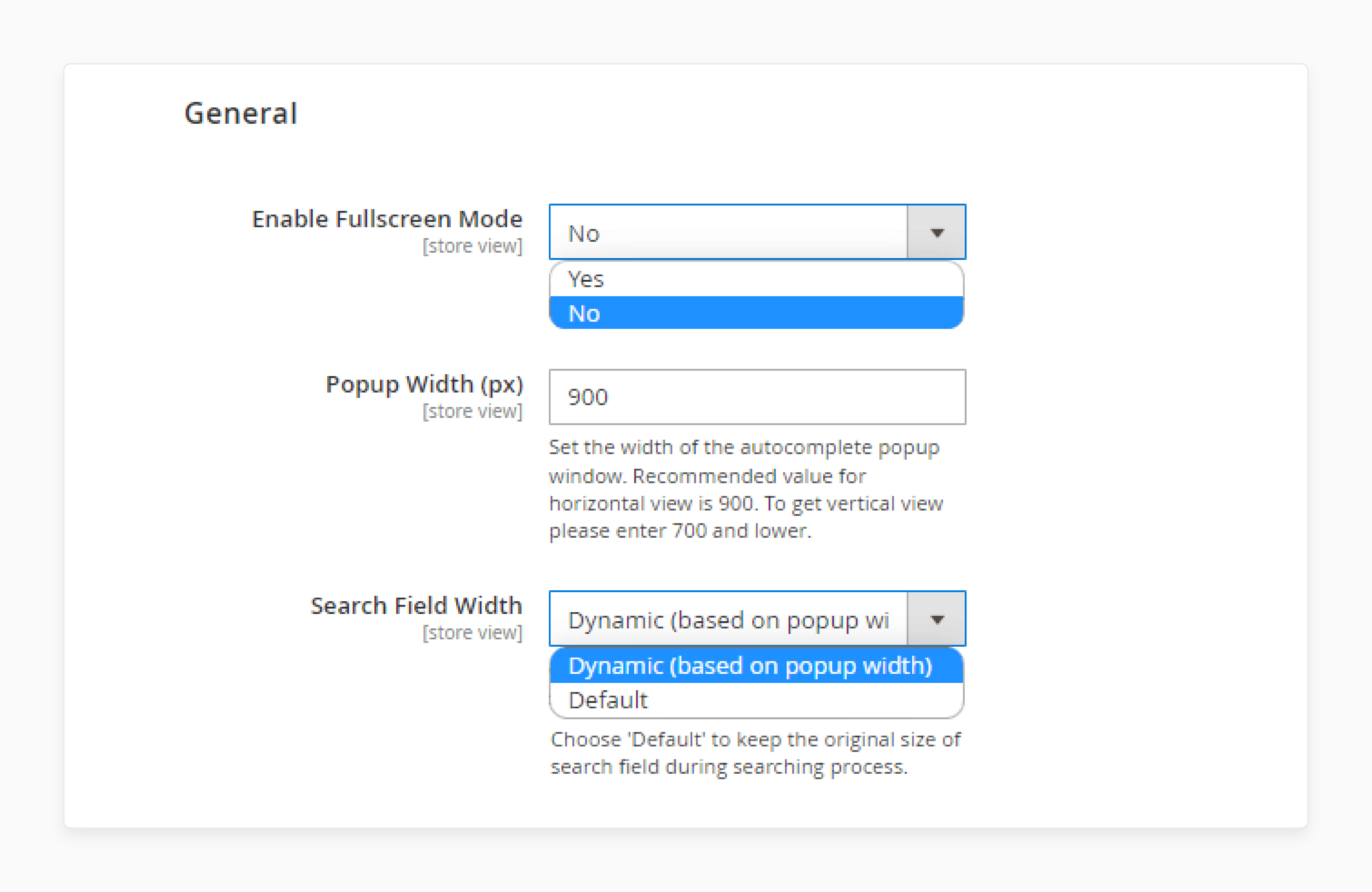
-
Enable full-screen mode in the settings.
-
Enter the Pop-up and search field width.
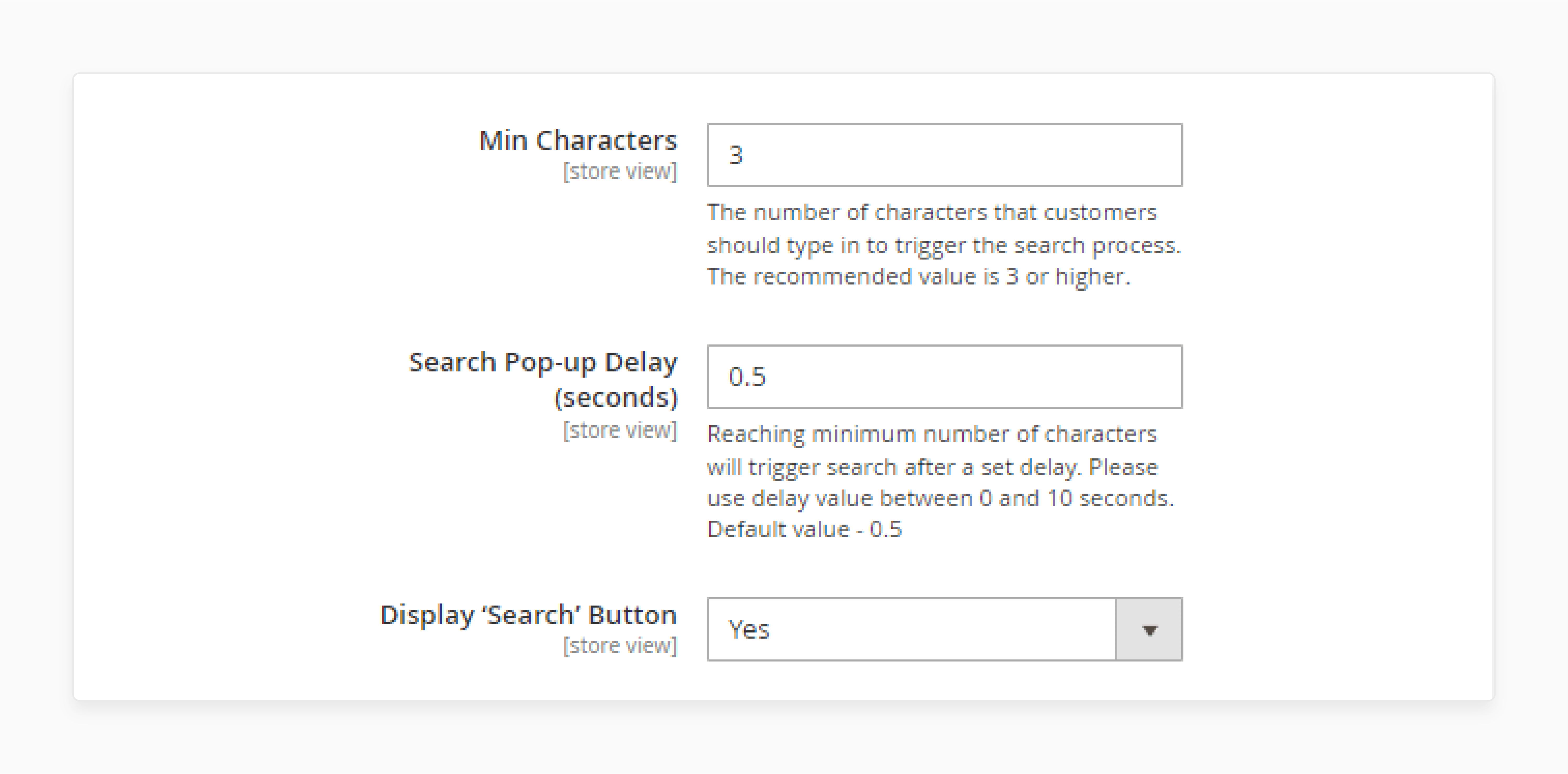
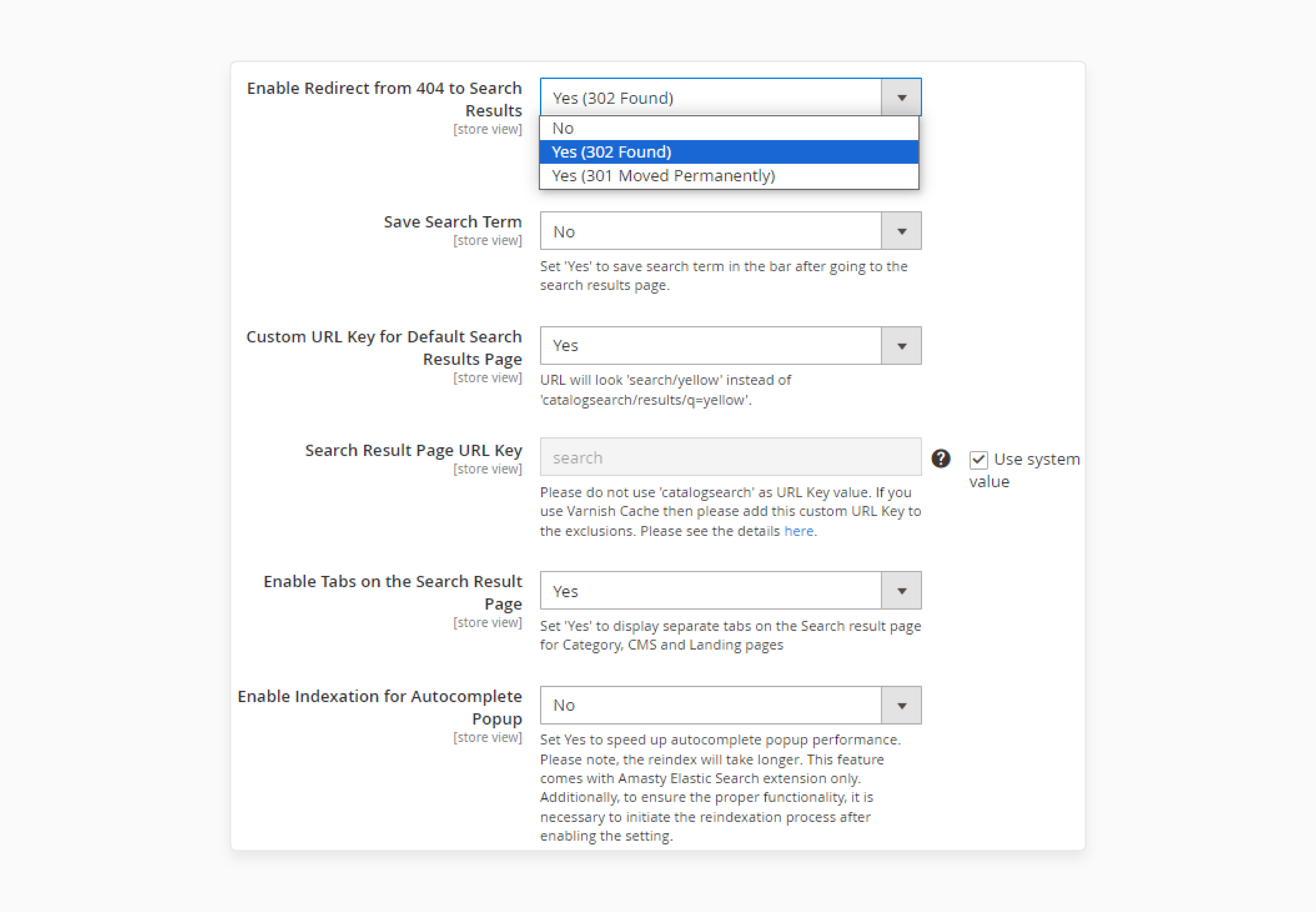
-
Enable the redirection option from 404 to search results.
-
Enable the tab on the search results page.
-
Enable Auto Indexation to autocomplete popup.
-
Select Yes to Show Related Search Queries.
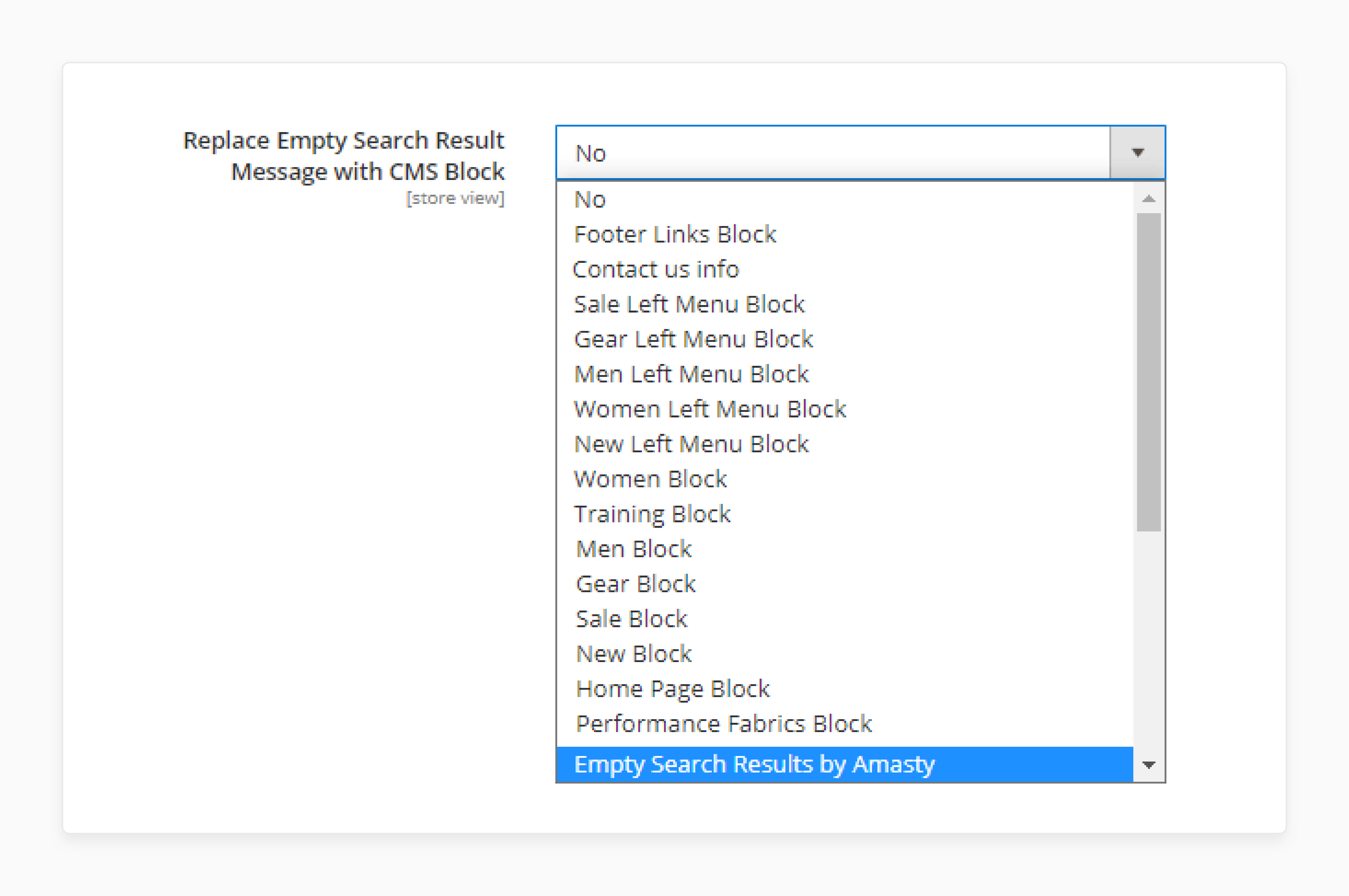
- Choose No to Replace Empty search menus.
Step 2: Search Request Limitation & Attributes
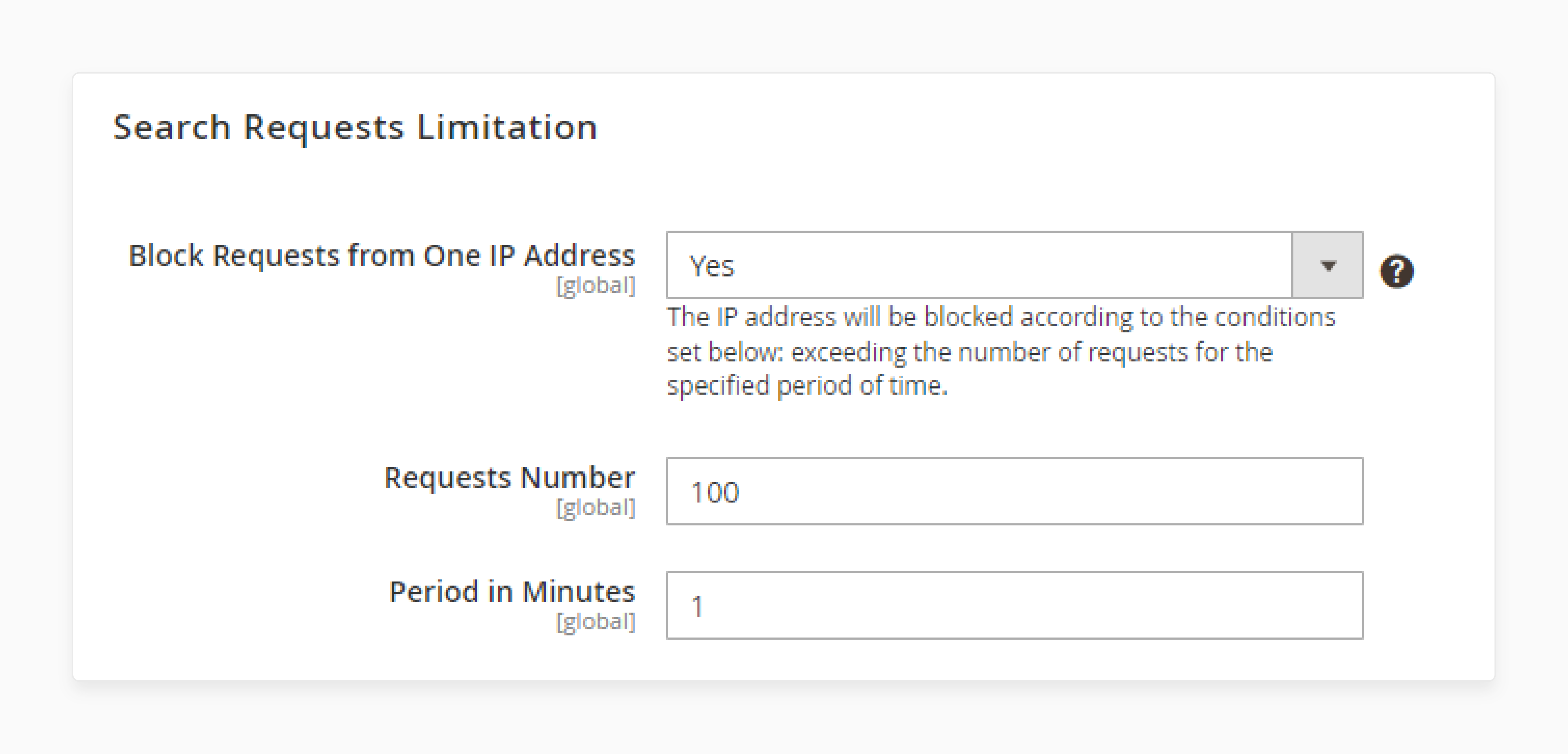
-
Choose Yes to block one IP request from one address.
-
Enter the Request Number and Period.
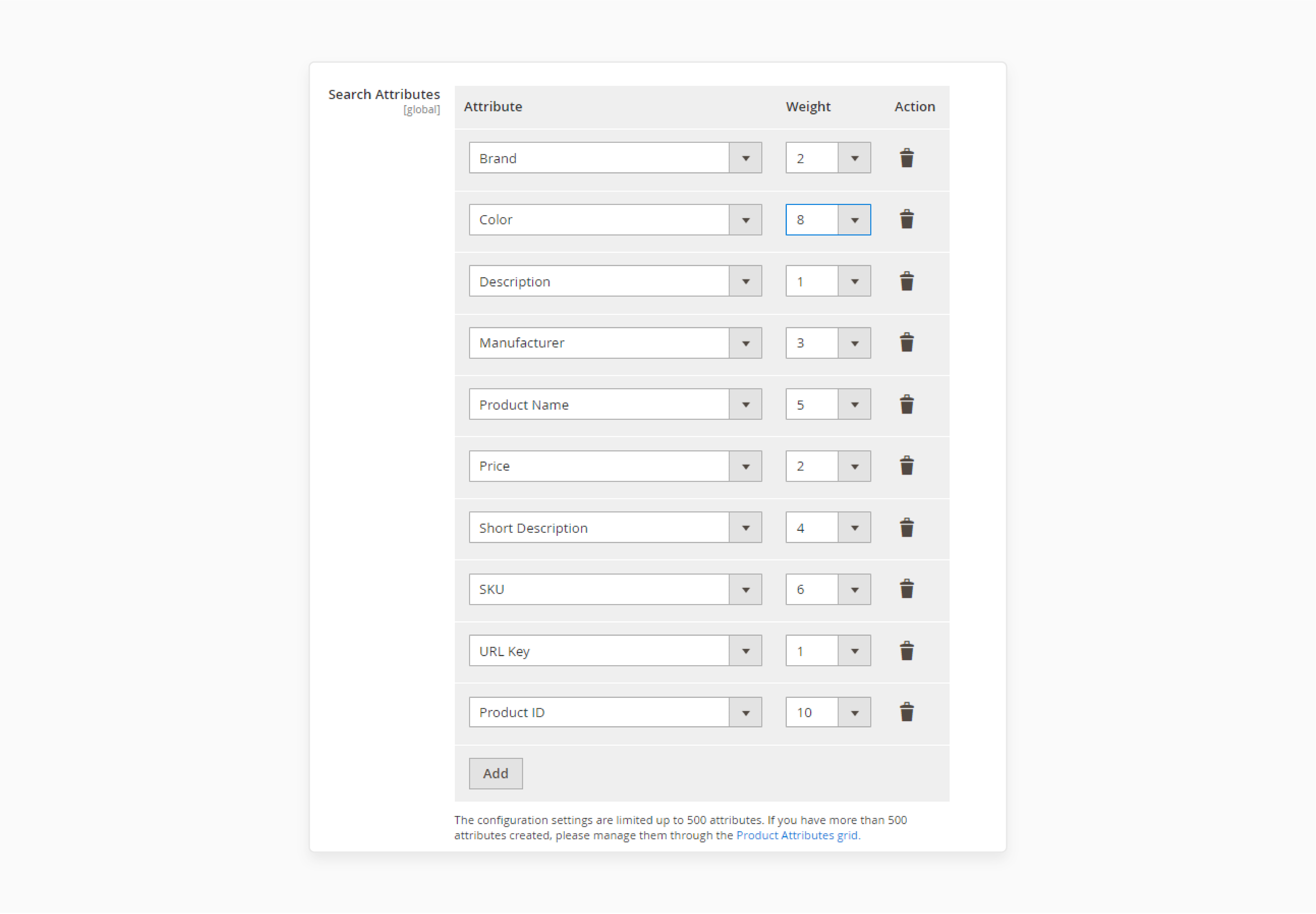
-
Select the Brand attributes and choose their weight accordingly.
-
Click on Add to add more attributes.
Step 3: Configuring the Products & Additional Blocks
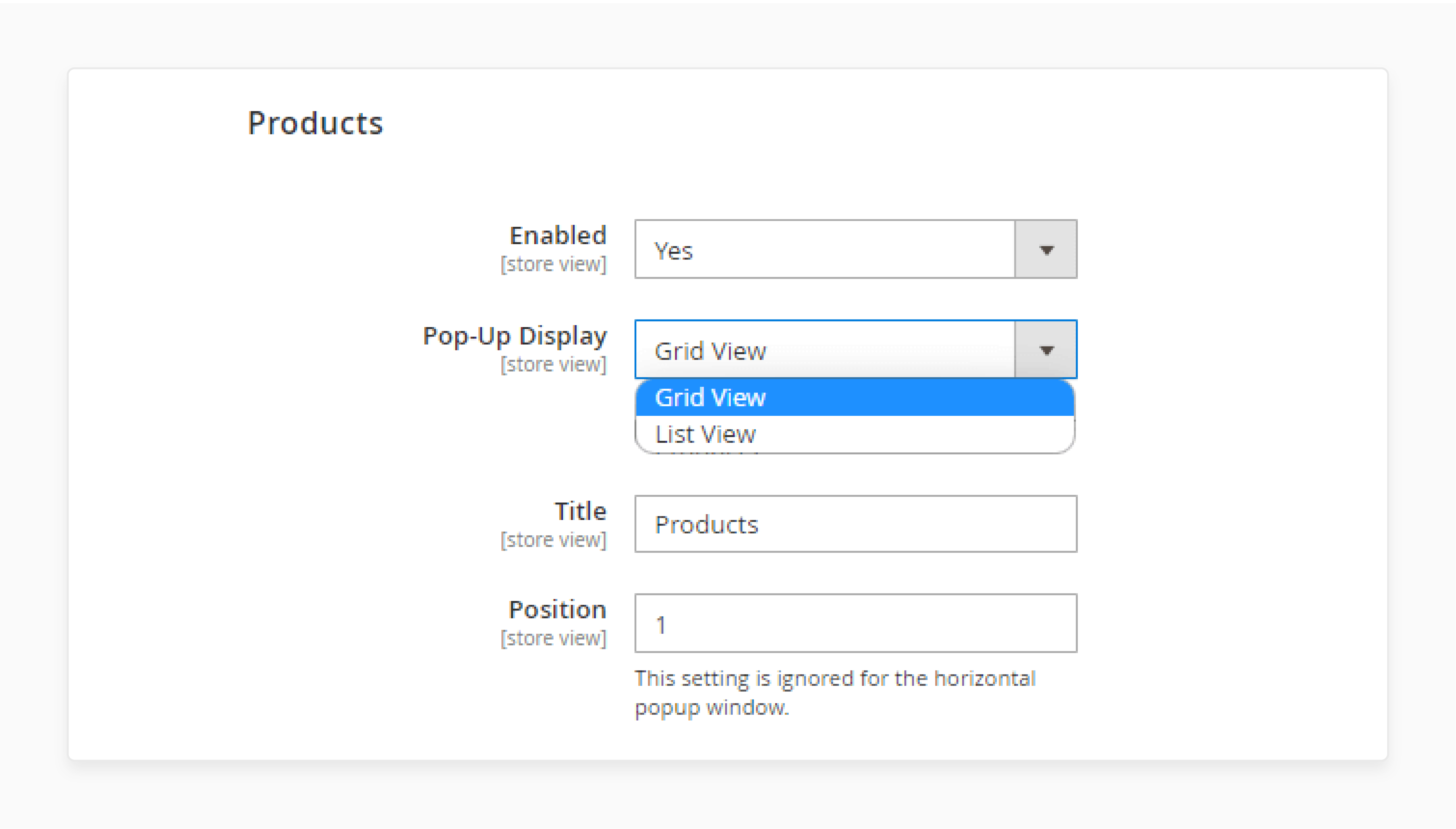
- Enable the Product Display and choose the Popup View.
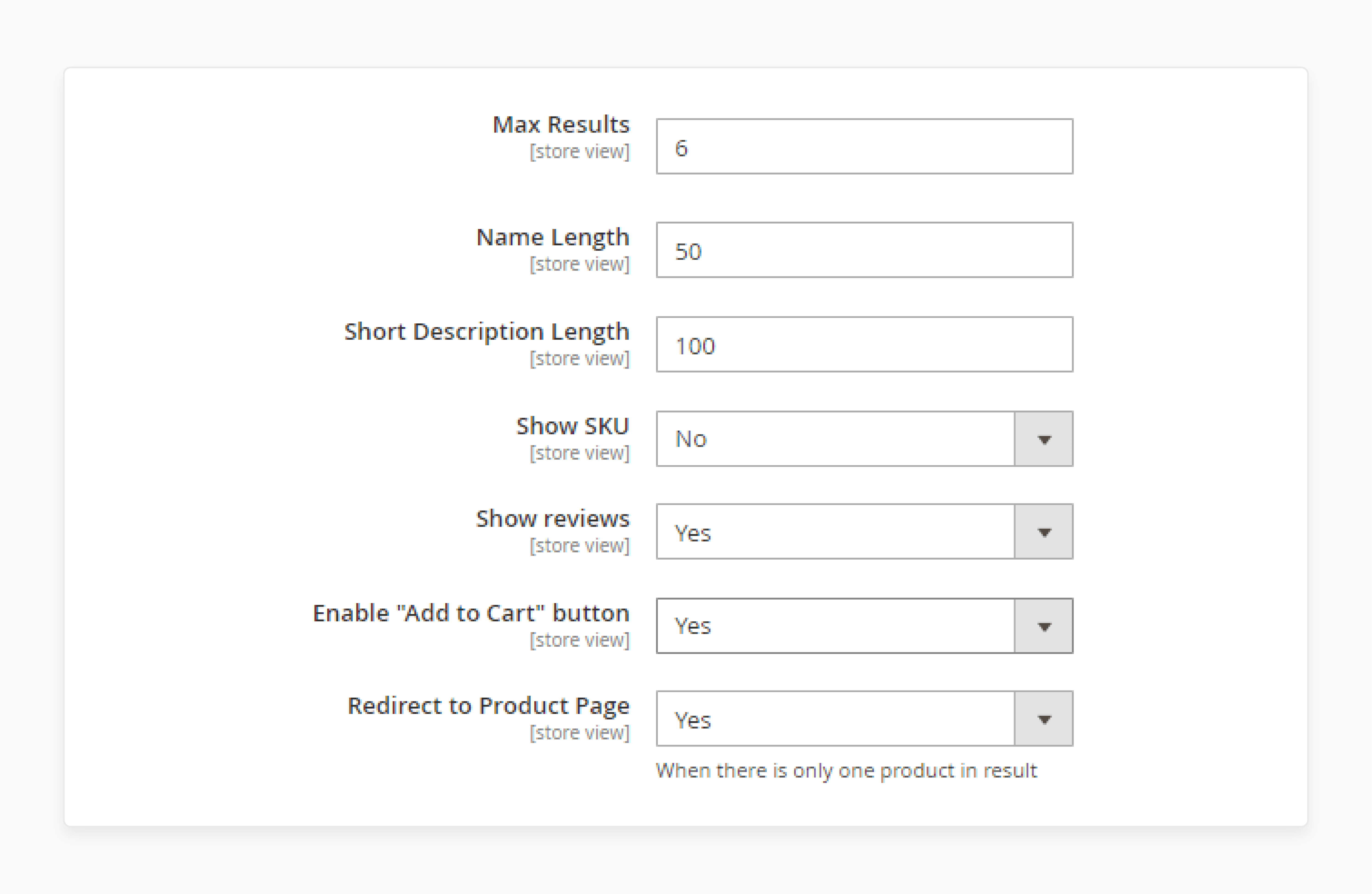
-
Enter the Maximum Results and Short Description length.
-
Enable the Add to Cart button and Redirect to the Product Page.
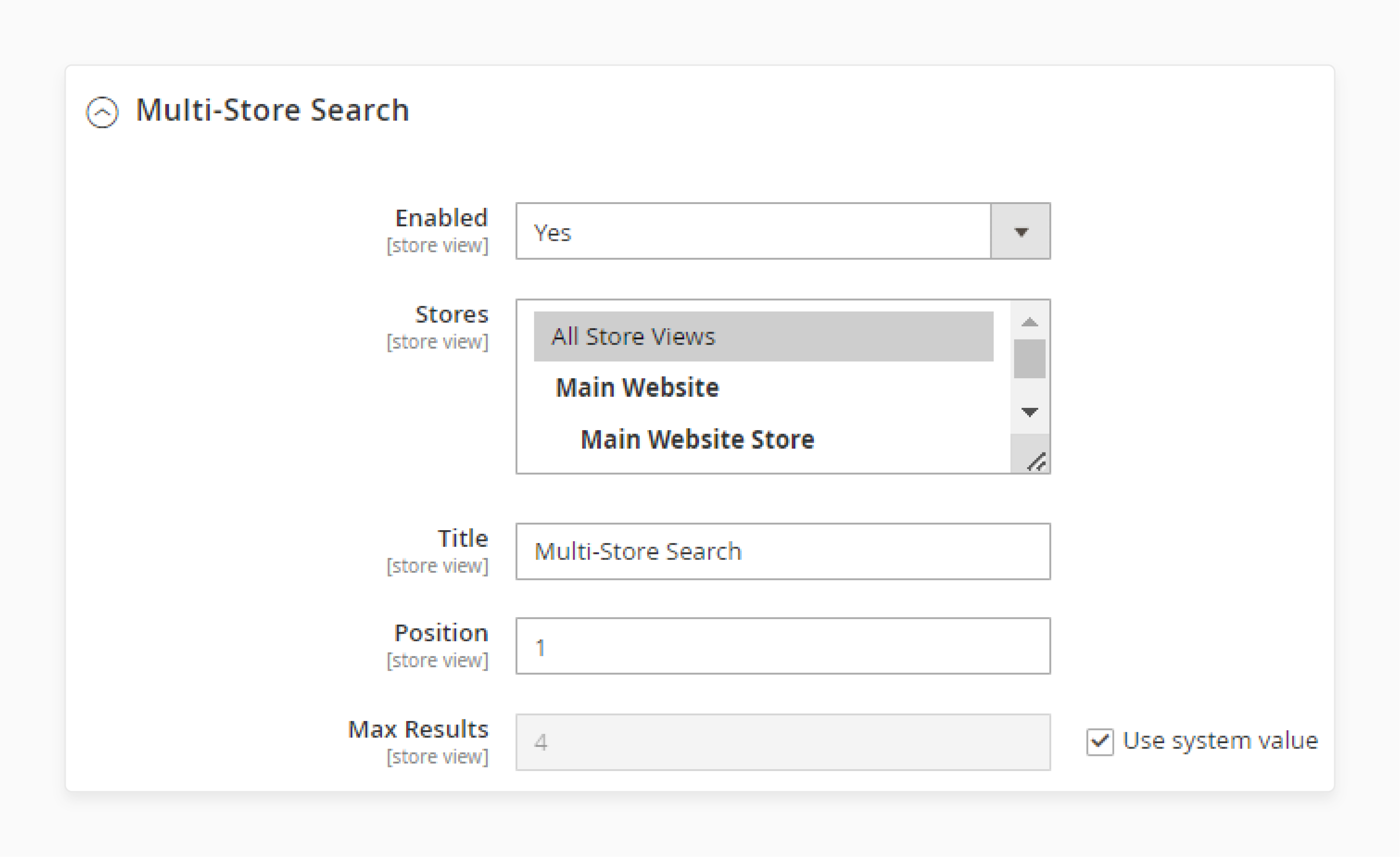
-
Enable Multi Store Search and select your Store.
-
Add Additional Blocks to your Magento Search for relevant searches.
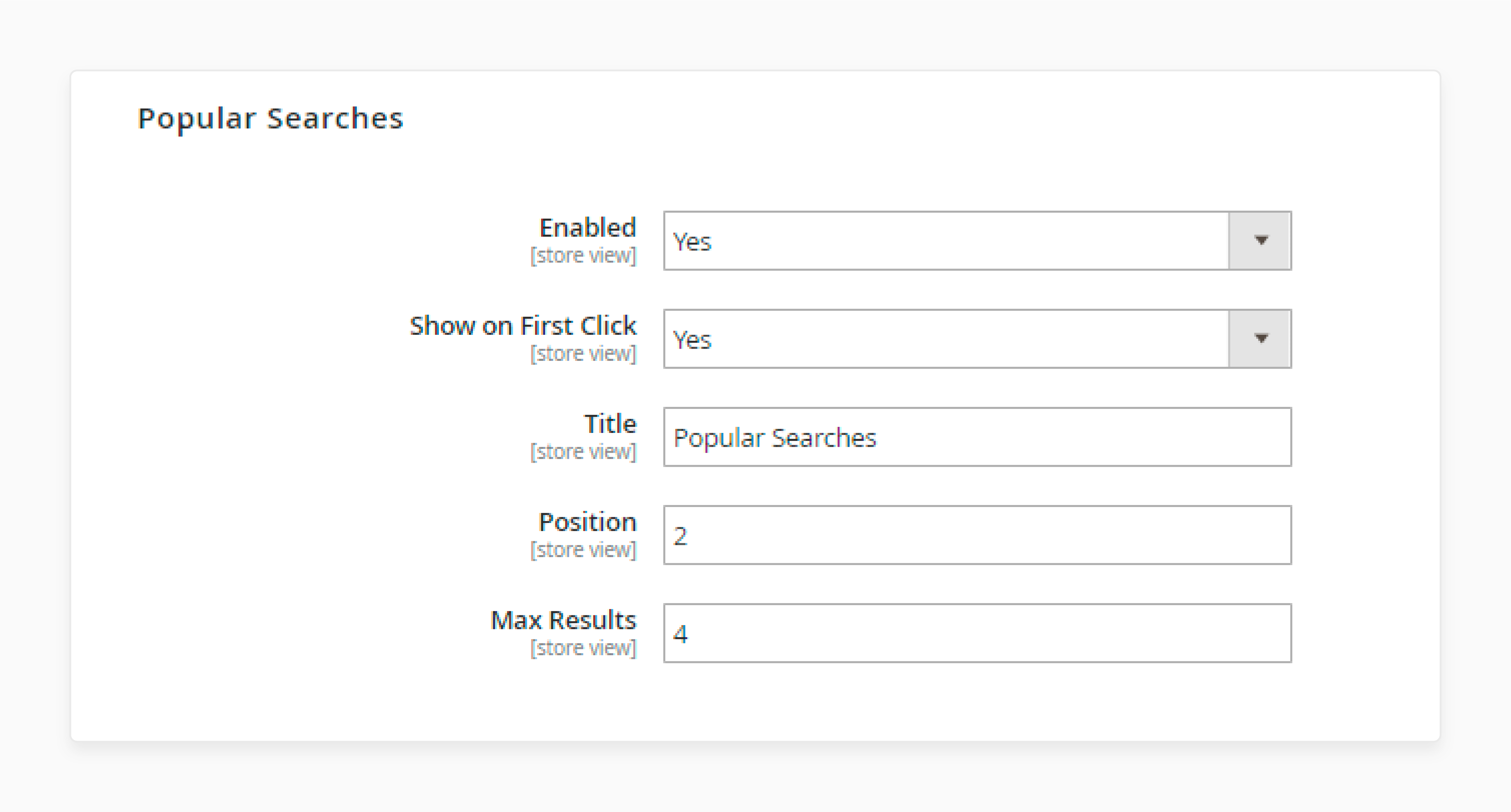
-
Enable Popular Searches and choose the Max results.
-
Repeat the above step for Browsing History, Magento CMS Pages, and Blogs.
-
Under Categories, add the specific ones to include in the store.
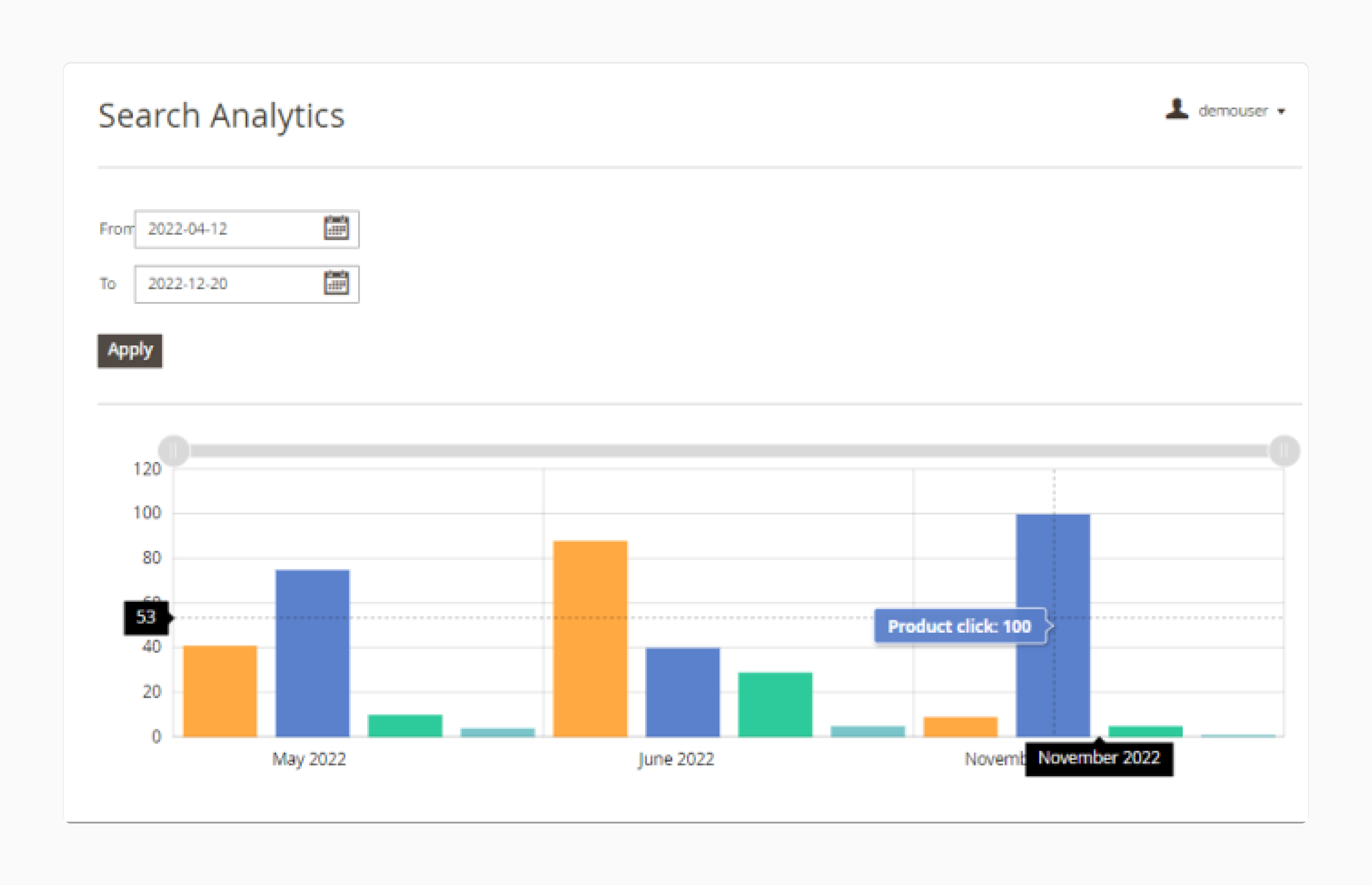
- Go to Admin panel > Reports > Search Analytics to view performance.
Best Practices to Optimize Queries Using the Advanced Search Extension
1. Use Autocomplete and Suggestions
-
This functionality provides users with real-time suggestions as they type their search queries. Magento Autocomplete displays relevant suggestions when users begin typing in the advanced search bar. This immediate feedback helps guide them toward relevant products.
-
This feature also reduces the likelihood of spelling errors. The function can still suggest the correct term if a user misspells a product name. This capability ensures that users do not get frustrated.
-
It can highlight trending products or categories. By showing these suggestions, store owners can promote specific items.
2. Use Weighted Search
-
It involves assigning different weights to Magento product attributes. This is based on their relevance to customer searches.
-
If color is a factor for your products, you can assign it a higher weight in the search engine. When users search for a color, the results prioritize products matching that attribute. Customers are likelier to see the most relevant options at the top of their search results.
-
It also improves conversion rates with search and autocomplete. When customers find it, they are more likely to make a purchase.
-
This practice allows for greater flexibility in product display. Store owners can adjust weights based on seasonal trends or marketing campaigns.
3. Analyze Search Data
-
Store owners can make informed decisions by understanding what customers are searching for.
-
One key aspect to focus on is identifying popular search terms. These are the queries that customers frequently enter when looking for products. By tracking, store owners can determine which products are in high demand.
-
Another essential factor to analyze is zero-result searches. These occur when customers enter a query but do not find any matching products. Monitoring these searches can reveal gaps in the Magento product catalog search. If specific terms yield no results, add new products or adjust existing ones.
-
Understanding search data can help refine marketing strategies. If specific terms are trending, store owners can create targeted promotions.
4. Optimize Product Attributes
-
Well-defined and relevant attributes improve customers' search experiences. When searching for products, users rely on these attributes to find their needs.
-
Start by ensuring that each product has clear and descriptive attributes. This includes essential details like SKU, which helps identify specific products. A well-defined SKU can optimize the search process.
-
Descriptions should highlight key features and specifications that are important to buyers. Incorporating other details, such as color, size, and brand, is also beneficial. The search extension helps these attributes allow customers to filter their searches.
5. Set Maximum & Minimum Query Lengths
-
The minimum query length helps prevent users from submitting short searches. These are unlikely to yield valuable results. For example, a single character or two may not provide enough context. By establishing a length, store owners can encourage users to be more descriptive.
-
Setting a maximum query length is equally important. Long queries can lead to excessive database load and slow the search feature. You can search by category configuration.
Common Issues & Solutions with Magento 2 Advanced Search
| Common Issue | Description | Solution |
|---|---|---|
| No Results Found | Users may search for products but receive a "no results" message. It is even when products exist in the catalog. | Check if the product attributes are set to be searchable. Ensure that the relevant attributes are indexed. |
| Autocomplete Not Working | The search autocomplete feature may not display suggestions. | Verify that the search is enabled and properly configured. Clear cache and reindex data if needed. Check for a block in the autocomplete popup. |
| Search Indexing Issues | Indexes may not be updated. It leads to outdated or missing search results. | Run the indexer command in the Magento admin panel. Use advanced search. |
| Search Engine Configuration Errors | Incorrect search engine configuration can lead to poor search performance. | Ensure that the correct search engine (like Elasticsearch) is selected. |
| Misconfigured Product Attributes | Product attributes may not be set to be searchable. It results in incomplete search results. | Edit product attributes to ensure they are marked as "Use in Search" and "Visible in Advanced Search." |
| Slow Search Performance | The search may respond slowly. It frustrates users and affects their shopping experience. | Optimize server settings and ensure that caching is configured correctly. |
| Search Suggestions Not Displaying | Users may not see relevant suggestions when typing in the search bar. | Enable search autocomplete in the settings and check if it functions correctly. |
FAQs
1. How does the Magento 2 Advanced Search module enhance search functionality?
The Magento 2 Advanced Search improves search functionality. It is by delivering relevant search results through features. It includes AJAX-based live search, multi-attribute filtering, and an autocomplete search popup. It is to ensure a faster and more intuitive user experience.
2. What is the benefit of using an advanced search extension for Magento 2?
An advanced search extension for Magento 2 allows store owners to use features. These include search by brand, category-specific searches, and store search results optimization. It enables customers to find what they need efficiently.
3. Can I configure the search extension to show results for Magento 2 by category?
Yes, the advanced search extension allows configuration for category-based searches. This enables customers to filter products effectively. You can view results in the search popup organized by specific categories.
4. Does the search extension support Elastic Search for Magento 2?
The Elastic Search for Magento 2 functionality integrates smoothly. It ensures an efficient search experience with fast and precise results. This is true even for large product catalogs.
5. What makes the Magento 2 search extension a great addition to my store?
The Magento search extension is a great extension for any store. It supports Magento multi-store search. It delivers an advanced search solution and enables features like autocomplete search. It also shows insights from a search terms report by date to optimize customer experience.
Summary
The Magento 2 advanced search feature helps users discover and purchase products faster. This tutorial explains the features and best practices for using the extension. Here is a quick recap:
-
Magento advanced search enhances product discovery with instant results.
-
Advanced search for Magento 2 enables customizable filtering options.
-
Magento search supports detailed analytics for improving queries.
-
Results shown in the search pop-up improve user engagement.
-
Trigger the search process to filter the most wanted results.
Choose managed Magento hosting with advanced searches for better visibility and performance.






